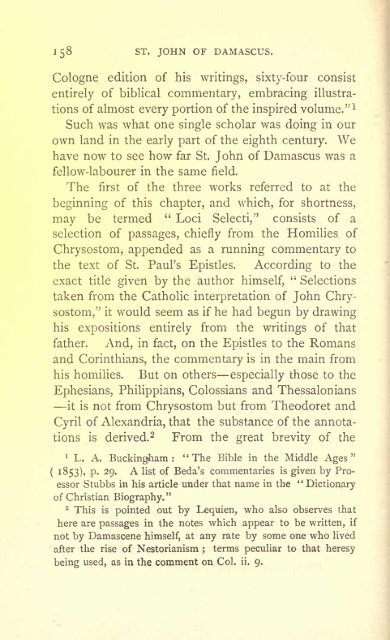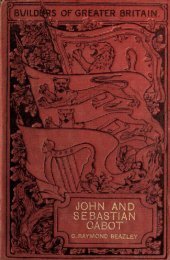st. john of damascus (676-749 - Cristo Raul
st. john of damascus (676-749 - Cristo Raul
st. john of damascus (676-749 - Cristo Raul
Create successful ePaper yourself
Turn your PDF publications into a flip-book with our unique Google optimized e-Paper software.
"<br />
"<br />
158 ST. JOHN OF DAMASCUS.<br />
Cologne edition <strong>of</strong> his writings, sixty-four consi<strong>st</strong><br />
entirely <strong>of</strong> biblical commentary, embracing illu<strong>st</strong>ra<br />
tions <strong>of</strong> almo<strong>st</strong> every portion <strong>of</strong> the inspired<br />
volume." 1<br />
Such was what one single scholar was doing in our<br />
own land in the early part <strong>of</strong> the eighth century. We<br />
have now to see how far St. John <strong>of</strong> Damascus was a<br />
fellow-labourer in the same field.<br />
The fir<strong>st</strong> <strong>of</strong> the three works referred to at the<br />
beginning <strong>of</strong> this chapter, and which, for shortness,<br />
be termed Loci Selecti,"<br />
consi<strong>st</strong>s <strong>of</strong> a<br />
may<br />
selection <strong>of</strong> passages, chiefly from the Homilies <strong>of</strong><br />
Chryso<strong>st</strong>om, appended as a running commentary to<br />
the text <strong>of</strong> St. Paul s Epi<strong>st</strong>les. According to the<br />
exact title given by the author himself, Selections<br />
taken from the Catholic interpretation <strong>of</strong> John Chry<br />
so<strong>st</strong>om," it would seem as if he had begun by drawing<br />
his expositions entirely from the writings <strong>of</strong> that<br />
father. And, in fact, on the Epi<strong>st</strong>les to the Romans<br />
and Corinthians, the commentary is in the main from<br />
his homilies. But on others especially those to the<br />
Ephesians, Philippians, Colossians and Thessalonians<br />
it is not from Chryso<strong>st</strong>om but from Theodoret and<br />
Cyril <strong>of</strong> Alexandria, that the sub<strong>st</strong>ance <strong>of</strong> the annota<br />
tions is derived. 2 From the great brevity <strong>of</strong> the<br />
1<br />
L. A. Buckingham: "The Bible in the Middle Ages"<br />
1853), p. 29. A li<strong>st</strong> <strong>of</strong> Beda s commentaries is given by Proessor<br />
(<br />
Stubbs in his article under that name in the "Dictionary<br />
<strong>of</strong> Chri<strong>st</strong>ian Biography."<br />
2<br />
This is pointed out by Lequien, who also observes that<br />
here are passages in the notes which appear to be written, if<br />
not by Damascene himself, at any rate by some one who lived<br />
after the rise <strong>of</strong> Ne<strong>st</strong>orianism ;<br />
terms peculiar to that heresy<br />
being used, as in the comment on Col. ii. 9.
















